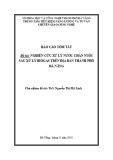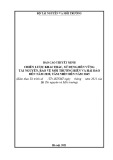
BioMed Central
Page 1 of 11
(page number not for citation purposes)
Implementation Science
Open Access
Research article
Municipal policies and plans of action aiming to promote physical
activity and healthy eating habits among schoolchildren in
Stockholm, Sweden: a cross-sectional study
Karin Guldbrandsson1,2, Karin Modig Wennerstad3 and Finn Rasmussen*3
Address: 1Division of Social Medicine, Department of Public Health Sciences, Norrbacka floor 5, Karolinska Institutet, SE-171 76 Stockholm,
Sweden, 2The Swedish National Institute of Public Health, Östersund, Sweden and 3Child and Adolescent Public Health Epidemiology Unit,
Department of Public Health Sciences, Norrbacka floor 5, Karolinska Institutet, SE-171 76 Stockholm, Sweden
Email: Karin Guldbrandsson - karin.guldbrandsson@ki.se; Karin Modig Wennerstad - karin.modig@ki.se;
Finn Rasmussen* - finn.rasmussen@ki.se
* Corresponding author
Abstract
Background: Promoting physical activity and healthy eating habits by structural measures that reach most
children in a society is presumably the most sustainable way of preventing development of overweight and obesity
in childhood. The main purpose of the present study was to analyse whether policies and plans of action at the
central level in municipalities increased the number of measures that aim to promote physical activity and healthy
eating habits among schoolchildren aged six to 16. Another purpose was to analyse whether demographic and
socio-economic characteristics were associated with the level of such measures.
Methods: Questionnaires were used to collect data from 25 municipalities and 18 town districts in Stockholm
County, Sweden. The questions were developed to capture municipal structural work and factors facilitating
physical activity and the development of healthy eating habits for children. Local policy documents and plans of
action were gathered. Information regarding municipal demographic and socio-economic characteristics was
collected from public statistics.
Results: Policy documents and plans of action in municipalities and town districts did not seem to influence the
number of measures aiming to promote physical activity and healthy eating habits among schoolchildren in
Stockholm County. Municipal demographic and socio-economic characteristics were, however, shown to
influence the number of measures. In town districts with a high total population size, and in municipalities and
town districts with a high proportion of adults with more than 12 years of education, a higher level of health-
promoting measures was found. In municipalities with a high annual population growth, the number of measures
was lower than in municipalities with a lower annual population growth. Another key finding was the lack of
agreement between what was reported in the questionnaires regarding existence and contents of local policies
and plans of action and what was actually found when these documents were scrutinized.
Conclusion: Policy documents and plans of action aiming to promote physical activity and healthy eating habits
among schoolchildren aged six to 16 in municipalities and town districts in Stockholm County did not seem to
have an impact on the local level of measures. Demographic and socio-economic characteristics of the
municipalities and town districts were on the other hand associated with local health-promoting measures.
Published: 3 August 2009
Implementation Science 2009, 4:47 doi:10.1186/1748-5908-4-47
Received: 8 January 2009
Accepted: 3 August 2009
This article is available from: http://www.implementationscience.com/content/4/1/47
© 2009 Guldbrandsson et al; licensee BioMed Central Ltd.
This is an Open Access article distributed under the terms of the Creative Commons Attribution License (http://creativecommons.org/licenses/by/2.0),
which permits unrestricted use, distribution, and reproduction in any medium, provided the original work is properly cited.

Implementation Science 2009, 4:47 http://www.implementationscience.com/content/4/1/47
Page 2 of 11
(page number not for citation purposes)
Background
Overweight and obesity are important health problems
among children and adolescents in the Western countries
[1-3]. A study conducted in Stockholm County, Sweden in
2003 showed that 20.5% of all boys were overweight, and
3.8% were obese. For girls, the corresponding prevalence
estimates were 19.2% and 2.8% [4]. Place of residence has
been shown to be significantly associated with body mass
index (BMI) in late adolescence and adulthood [5,6].
Strong socio-economic gradients with higher prevalence
of overweight and obese children and adolescents from
disadvantaged groups have been reported in Sweden and
Canada [7,8]. There are several mechanisms of the obesity
epidemic, but physical activity and eating habits are
strongly related to weight development at a population
level. A recent study from Stockholm showed that 71% of
15-year-olds were physically active at a moderate or high
level for 60 minutes per day or more [9]. It was also
shown, however, that adolescents with a lower educated
mother, those in overcrowded accommodation, and those
with immigrant background were the most sedentary. It
was recently reported that only about one-third of those
aged 15 years and older in the European Union are phys-
ically active at the recommended levels [10], indicating
that in many European countries adolescents may be less
active than in Sweden. This also applies to children
between the ages of 11 and 15 [11].
Adults can more or less make their own lifestyle choices,
but children are left with parental decisions and socio-cul-
tural family environment as well as structural factors
related to schools, the local community, and society as a
whole [10]. Interventions at the family level will depend
on the families' ability to follow advice and make behav-
ioural changes, and results are therefore likely to be
related to social class and parental educational level. Inter-
ventions at school and/or municipal levels, however, pro-
vide good opportunities to set up structures that support
physical activity and healthy eating habits reaching all
children, regardless of socio-economic family position.
Such structures can be either obesogenic, meaning that
they prevent or hinder healthy behaviours, or leptogenic,
meaning that they encourage healthy behaviours [12,13].
A theoretical framework based on obesogenic and lep-
togenic environments has been developed by Swinburn
and colleagues. This framework is divided into the politi-
cal environment, the physical environment, the economic
environment, and the socio-cultural environment [12].
Examples related to physical activities are adjustments of
infrastructure such as traffic-calming measures aiming to
increase pedestrian and bicycle safety [14,15]. In a system-
atic review, van Sluijs, McMinn, and Griffin stated that
interventions, including both school and family or com-
munity involvement, have a better potential to increase
levels of physical activity among adolescents than inter-
ventions focusing only on one of these levels. [16].
Research has also shown that access to facilities such as
parks and activity programmes and time spent outdoors
are positively related with levels of physical activity
among children [17]. The Guidelines for School Lunches,
developed in Sweden by the Swedish National Food
Administration, is an example of structural factors pro-
moting healthy eating habits. Other examples of health-
promoting factors are absence of soda machines and
candy stores in and around schools and food policies in
schools [18,19].
The factors described above are examples of environments
supporting physical activity and healthy eating habits.
Starting with the Ottawa conference in 1986, a new
broader understanding of health promotion was adopted
[20]. It was subsequently realised that changes at the soci-
etal level often is a more feasible and efficient way of facil-
itating lifestyle changes at a population level than
interventions aimed at behavioural change at the individ-
ual level [21], and policy-making became an issue on the
public health arena. The policy process is often described
in several stages, e.g., problem identification, policy for-
mulation, policy implementation, and policy evaluation
[22]. According to this, structured public health work nor-
mally comprises policies, plans of action, implementation
measures, and evaluations. Such structured work has been
shown to be successful, e.g., in safety promotion [23].
In Sweden, the municipalities are accountable for the
main part of the arenas where children and adolescents
spend considerable amounts of their time, e.g., preschools
and schools as well as local infrastructure such as the route
to school, playgrounds, and leisure environments. The
Swedish compulsory school comprises children aged six
to 16. Swedish municipalities have, like municipalities in
many other welfare states [24], unique conditions regard-
ing self-government, democratic control, and tax equalisa-
tion that take into account age distribution, tax-paying
capacity, and population density. This autonomy implies
that while the national government legislates on the
building, traffic, and school environments, it cannot pre-
scribe exactly how the local governments shall put these
laws into practice. Public authorities, such as the Swedish
National Institute of Public Health, have developed pub-
lic health objectives that also address healthy eating and
physical activity. These objectives are not imperative,
however, but guiding principles for the municipalities. In
large municipalities, the local government is often decen-
tralised to town districts. Thus, municipalities and town
districts seem to be the proper arenas for structural health-
promoting actions that aim to reach a large proportion of
the children and adolescents.

Implementation Science 2009, 4:47 http://www.implementationscience.com/content/4/1/47
Page 3 of 11
(page number not for citation purposes)
In the light of these circumstances, the aims of our study
were threefold: first, we wanted to investigate whether
policies and plans of action at a central municipal level
increased the number of measures carried out to promote
physical activity and healthy eating habits among school-
children aged six to 16; second, we intended to investigate
to which extent such measures were given priority in
municipalities and town districts, i.e., whether physical
activity and healthy eating habits among schoolchildren
were judged to be important by local decision-makers;
third, we wished to explore whether municipal demo-
graphic and socio-economic characteristics were associ-
ated with the amount of local measures carried out to
promote physical activity and healthy eating habits
among schoolchildren.
Methods
In this cross-sectional study, questionnaires and public
statistics were used to collect data from all municipalities
(9,000 to 91,000 inhabitants) in Stockholm County. In
addition, the town districts of the municipality of Stock-
holm, the largest municipality in Sweden (794,500 inhab-
itants), were included.
Indicators were developed and survey questions con-
structed in order to capture the work carried out by the
municipalities at a structural level to enable children and
adolescents to be physically active and to develop healthy
eating habits. This was done by searching the literature
and by consulting health-planning officers and other
experts in the municipalities. We used the theoretical
framework for obesogenic environments developed by
Swinburn and colleagues, which is divided into the polit-
ical environment (e.g., policies, plans of action and sys-
tematic follow-up at the central level), the physical
environment (e.g., ability to walk and bike and public
accessibility to sports facilities), the economic environ-
ment (e.g., free or subsidised entrance to sports facilities,
subsidies to sports clubs, and free school lunches) and the
socio-cultural environment (e.g., attitudes to health pro-
motion among decision makers, public officials, and
school headmasters) [12]. Attitudes to health promotion
among municipal decision makers were supposed to be
revealed through questions regarding how health-pro-
moting measures were prioritised in the municipality. The
Swinburn conceptual framework was used to construct
and categorise the blocks of questions used in the ques-
tionnaires (Table 1). The first part of the questionnaire
aimed to identify and characterise structured public
health work (the political environment), and was built on
three often-mentioned stages in the policy process [22]:
policy formulation (are there any policies aiming to pro-
mote physical activity and/or healthy eating habits, and
are there any plans of action aiming to promote physical
activity and/or healthy eating habits?), policy implemen-
tation (are any measures of implementation taken to pro-
mote physical activity and/or healthy eating habits?), and
policy evaluation (are systematic follow-ups of imple-
mented measures performed?) [25-27]. The concepts pol-
icy, plan of action, and evaluation were defined in the
questionnaire. In order to distinguish measures related to
the physical, economic, and socio-cultural environments,
questions based on previous research [28-39] were used
(Table 1).
The questionnaires were sent by mail to all municipalities
(N = 25) in Stockholm County in late 2005 and early
2006. Due to the large population size of the Stockholm
municipality, the local political and administrative
responsibilities have been delegated to town districts.
Accordingly the questionnaires were also sent to all town
districts in the Stockholm municipality (N = 18). Two
written reminders and one final reminder by telephone
were given. The response to each question was coded with
the intention to reflect the level of measures. Question
group scores were computed within each block of ques-
tions (the political, physical, economic, and socio-cul-
tural environment). These question group scores were
designed to mirror the measures taken within each block
of questions. The measures were not weighed regarding
quality of evidence or reach into the municipalities. Thus,
all measures were given equal weight. Only fully appropri-
ate responses to the questions were scored as if the munic-
ipality or town district provided significant activity, as
explained in Table 2.
As a validity measure, policy documents and plans of
action were gathered from the municipalities and town
districts, and compared to the answers given in the ques-
tionnaires. The survey questions 'are there any policies
aiming to promote physical activity and/or healthy eating
among schoolchildren?' and 'are there any plans of action
aiming to promote physical activity and/or healthy eating
among schoolchildren?' were compared to the collected
policy documents and plans of action and coded in the
following manner: five criteria had to be fulfilled in order
for these questions to be validated and coded as 'yes, there
exists a policy/plan of action', namely: the response in the
questionnaire should be 'yes'; the policy/plan of action
should be attached; the attached policy should be politi-
cally adopted; the attached policy should be of contempo-
raneous relevance; and the attached policy should contain
clear and measurable aims regarding physical activity
and/or healthy eating habits among children and adoles-
cents. Answers to question two and three were mostly
found in the attached policy documents and plans of
action, but also on the websites of the municipalities.
Questions three to five in the validity control also consti-
tuted a means of checking the quality of the policy docu-
ments and plans of action. If a policy document was not

Implementation Science 2009, 4:47 http://www.implementationscience.com/content/4/1/47
Page 4 of 11
(page number not for citation purposes)
Table 1: Environmental perspectives (Swinburn et al. 1999) related to survey questions supported by previous research.
Environmental perspectives Survey questions References
Political environment Are there any policies aiming to promote physical activity and/or healthy eating? [25-27]
Are there any plans of action aiming to promote physical activity and/or healthy eating?
Are there any implementation measures made to promote physical activity and/or healthy eating?
Are systematic follow-ups of implemented measures performed?
Are objectives, plans and evaluations regarding physical activity stated in the municipal school plan?
Are objectives, plans and evaluations regarding healthy eating stated in the municipal school plan?
Economic environment Are there any incentives provided in order to increase the use of sports centres among children? [28,29]
Socio-cultural environment
(Attitudes to health promotion among municipal decision-makers
were supposed to be revealed by questions regarding how health-
promoting measures were prioritised in the municipality)
Are there any measures taken in order to increase walking and biking to school and in general? [30,31]
Have any overhauls of walking and bike paths been performed in the last five years?
Have any overhauls of walking and bike paths to and from schools been performed in the last five years?
Have any overhauls of the traffic safety in the immediate vicinity of the schools been performed in the last five
years?
Compared to the municipal road network, how prioritized are the bike paths regarding maintenance during
wintertime?
Is there any public health officer or similar staff employed in the municipality?
Is there any diet head or diet coordinator employed in the municipality?
Physical environment Are up-to-date and weatherproof bike stands provided? [32-39]
Are bike paths maintained during wintertime?
Has a general speed limit of 30 km/h been implemented in housing areas?
Part of total bike paths separated from road traffic
Kilometers of biking paths in relation to municipal road network.
Kilometers of walking paths in relation to municipal road network.

Implementation Science 2009, 4:47 http://www.implementationscience.com/content/4/1/47
Page 5 of 11
(page number not for citation purposes)
Table 2: Measures taken aiming to facilitate physical activity and healthy eating habits among school children in 23 municipalities and 17 town districts in Stockholm County
Environmental perspectives Survey questions Number of municipalities with
significant measures taken
Number of town districts with
significant measures taken
Political environment Are there any policies aiming to promote physical activity and/or healthy
eating?
Significant measures taken = Yes, AND the policy should be attached AND be
politically adopted AND be of present interest AND contain clear and
measurable aims.
61
Are there any plans of action aiming to promote physical activity and/or
healthy eating?
Significant measures taken = Yes, AND the plan of action should be attached
AND be politically adopted AND be of present interest AND contain clear
guiding principles on how to reach the aims in the policy.
32
Are there any implementation measures made to promote physical
activity and/or healthy eating?
Significant measures taken = Yes, and there is a responsible person
12
Are systematic follow-ups of implemented measures performed?
Significant measures taken = Yes, and there is a responsible person
02
Are objectives, plans, and evaluations regarding physical activity stated in
the municipal school plan?
Significant measures taken = Yes, AND the school plan should be attached
AND contain measurable aims AND follow-up intentions AND a responsible
person
82
Are objectives, plans, and evaluations regarding healthy eating stated in
the municipal school plan?
Significant measures taken = Yes, AND the school plan should be attached
AND contain measurable aims AND follow-up intentions AND a responsible
person
82
Economic environment Are there any incentives provided in order to increase the use of sports
centres among children?
Significant measures taken = Yes, AND a sufficient example
55
Socio-cultural environment Are there any measures taken in order to increase walking and biking to
school and in general?
Significant measures taken = Yes, measures are taken to increase both walking
and biking to school
14 11
Have any overhauls of walking and bike paths been performed in the last
five years?
Significant measures taken = Yes, all walking and bike paths
94
















![Báo cáo seminar chuyên ngành Công nghệ hóa học và thực phẩm [Mới nhất]](https://cdn.tailieu.vn/images/document/thumbnail/2025/20250711/hienkelvinzoi@gmail.com/135x160/47051752458701.jpg)









